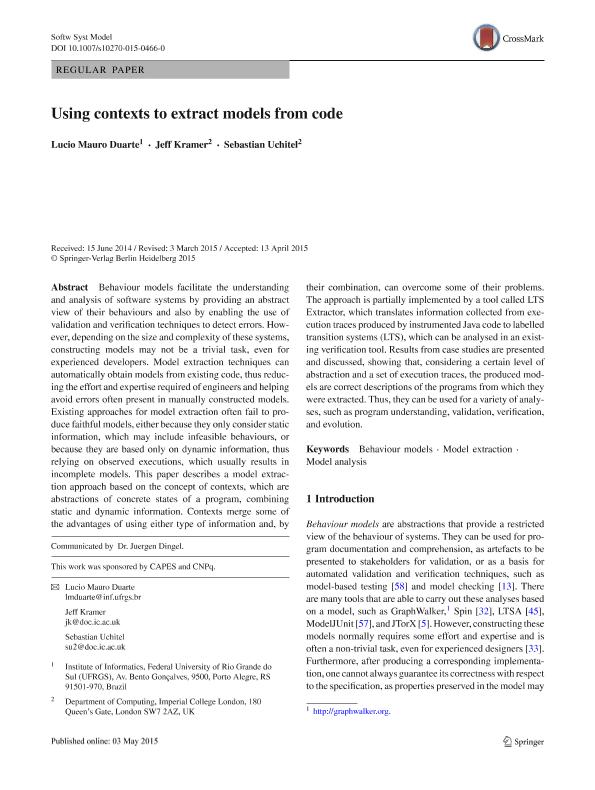Mostrar el registro sencillo del ítem
dc.contributor.author
Duarte, Lucio Mauro
dc.contributor.author
Kramer, Jeff

dc.contributor.author
Uchitel, Sebastian

dc.date.available
2018-09-13T18:58:17Z
dc.date.issued
2017-05
dc.identifier.citation
Duarte, Lucio Mauro; Kramer, Jeff; Uchitel, Sebastian; Using contexts to extract models from code; Springer Heidelberg; Software and Systems Modeling; 16; 2; 5-2017; 523-557
dc.identifier.issn
1619-1366
dc.identifier.uri
http://hdl.handle.net/11336/59590
dc.description.abstract
Behaviour models facilitate the understanding and analysis of software systems by providing an abstract view of their behaviours and also by enabling the use of validation and verification techniques to detect errors. However, depending on the size and complexity of these systems, constructing models may not be a trivial task, even for experienced developers. Model extraction techniques can automatically obtain models from existing code, thus reducing the effort and expertise required of engineers and helping avoid errors often present in manually constructed models. Existing approaches for model extraction often fail to produce faithful models, either because they only consider static information, which may include infeasible behaviours, or because they are based only on dynamic information, thus relying on observed executions, which usually results in incomplete models. This paper describes a model extraction approach based on the concept of contexts, which are abstractions of concrete states of a program, combining static and dynamic information. Contexts merge some of the advantages of using either type of information and, by their combination, can overcome some of their problems. The approach is partially implemented by a tool called LTS Extractor, which translates information collected from execution traces produced by instrumented Java code to labelled transition systems (LTS), which can be analysed in an existing verification tool. Results from case studies are presented and discussed, showing that, considering a certain level of abstraction and a set of execution traces, the produced models are correct descriptions of the programs from which they were extracted. Thus, they can be used for a variety of analyses, such as program understanding, validation, verification, and evolution.
dc.format
application/pdf
dc.language.iso
eng
dc.publisher
Springer Heidelberg

dc.rights
info:eu-repo/semantics/openAccess
dc.rights.uri
https://creativecommons.org/licenses/by-nc-sa/2.5/ar/
dc.subject
Behaviour Models
dc.subject
Model Analysis
dc.subject
Model Extraction
dc.subject.classification
Ciencias de la Computación

dc.subject.classification
Ciencias de la Computación e Información

dc.subject.classification
CIENCIAS NATURALES Y EXACTAS

dc.title
Using contexts to extract models from code
dc.type
info:eu-repo/semantics/article
dc.type
info:ar-repo/semantics/artículo
dc.type
info:eu-repo/semantics/publishedVersion
dc.date.updated
2018-09-13T13:13:07Z
dc.journal.volume
16
dc.journal.number
2
dc.journal.pagination
523-557
dc.journal.pais
Alemania

dc.journal.ciudad
Heidelberg
dc.description.fil
Fil: Duarte, Lucio Mauro. Federal University of Rio Grande do Sul; Brasil
dc.description.fil
Fil: Kramer, Jeff. Imperial College London; Reino Unido
dc.description.fil
Fil: Uchitel, Sebastian. Consejo Nacional de Investigaciones Científicas y Técnicas; Argentina. Imperial College London; Reino Unido
dc.journal.title
Software and Systems Modeling

dc.relation.alternativeid
info:eu-repo/semantics/altIdentifier/doi/https://dx.doi.org/10.1007/s10270-015-0466-0
dc.relation.alternativeid
info:eu-repo/semantics/altIdentifier/url/https://link.springer.com/article/10.1007/s10270-015-0466-0
Archivos asociados
